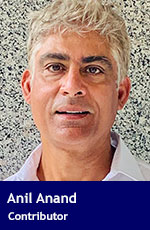 The COVID-19 pandemic may be the most important event of our lifetimes. It will define the legitimacy of governments and leave long-lasting impressions about how societies responded on behalf of their citizens.
The COVID-19 pandemic may be the most important event of our lifetimes. It will define the legitimacy of governments and leave long-lasting impressions about how societies responded on behalf of their citizens.
The devastation being played out across India is beyond tragic – it was predictable, ignored, supported by willful blindness and even encouraged. As a result, we have to ask: What’s India’s future?
You can’t exit an airport in India without being struck with the enormity and complexity of the problems this emerging economy faces. That’s superimposed on paradox, since this is a nation with space missions, 140 billionaires and the world’s fifth largest economy. None of that is evident at first, second or third glance.
I’ve visited India several times, travelled extensively across the country and spent time with people from all walks of life.
Three justifications have contributed to the current crisis.
A sense of false national exceptionalism led to the widespread belief that Indians had, through exposure to other pathogens, an enhanced ability to resist the effects of COVID-19.
Added to this was a sense of false exceptionalism regarding India’s medical system and bio-technological capabilities. But that system from any pragmatic and impartial view is clearly archaic.
Added to this are ill-conceived policies, compounded by anecdotal science, that had the country’s population undertake mass dispersion from urban to rural areas, spreading the virus ever wider. The lockdown itself became a super-spreader event.
Indians were told that they’re unlike any other people, that they wouldn’t experience the same levels and intensity of infections as others around the world. High-ranking officials advanced theories, without any scientific foundation, that higher tolerance to infection, including India’s hot climate as a mitigating influence, its younger demographics, and homeopathy were uniquely Indian defences against the intensity of the pandemic. These messages contributed to teeming markets, sports events and transportation networks.
On one hand authorities attested to mass testing, preparation of mass treatment facilities, and lockdowns and restrictions to control the spread of the virus. On the other, very few businesses and social events were allowed and promoted.
The population is the second excuse at the heart of every rationalization of every socio-ethnographic challenge. But this excuse for inept and failed national policies, or lack of policies, has allowed them to persist for far too long.
India’s population was mere 353 million at its independence in 1947, 450.6 million in 1960, 555.2 million in 1970, 819.7 million in 1987 and one billion by 1997. Today, the population is nearly 1.4 billion, a billion people more than at the time of independence.
There’s a systematic tendency to blame the population boom on external forces. But the population explosion has occurred while India has been under the governance and policies of Indians.
There have been many opportunities when India could have invested in family planning, education and support policies to curb runaway population growth. This simply has not occurred beyond symbolic efforts.
One of the reasons those policies have never succeeded is religion. Policies are based on a fear of religious sectarianism, which has been the foundation of ongoing conflicts between Muslims, Hindus and Sikhs since 1947. The ruling Bharatiya Janata Party (BJP) is firmly founded in Hindu nationalism and all the bigotry and xenophobia that accompany such movements.
Muslims have been blamed for practising polygamy and having large families. India’s approximately 172 million Muslims have been exempt from polygamy laws, which are now being challenged before the Supreme Court. This sectarian divide has been the cause of dozens of riots and thousands of deaths over the past several decades, the most recent in March 2020. The resulting xenophobia has divided the country further, adding to a repugnant persistence of the religious bigotry, caste and class systems.
Neo-nationalistic policies and religious fundamentalism have permitted the world’s largest mass gathering at the Kumbh Mela, a Hindu festival that draws upwards of hundreds of millions of devotees to meet at the Ganges.
This too is an expression of xenophobia that divides the country. It’s a far cry from the arrests and stigmatization of Muslims blamed for a surge in infections after about 8,000 people in the Tablighi Jamaat congregated in March 2020. Prime Minister Narendra Modi’s government arrested 29 people, including 16 foreigners, who participated in the missionary meeting.
Also in March 2020, Indian authorities in the northern state of Punjab quarantined about 40,000 residents from 20 villages following a COVID-19 outbreak linked to a Sikh preacher who had ignored advice to self-quarantine and attended a religious gathering. No arrests were reported.
The current tragedy is as much a result of willful blindness as willful ignorance.
In the 70-plus years since independence, India has seen the addition of one billion citizens, persistent communalism and little change in the prospects of the marginalized. It has no one to blame but itself.
Meanwhile, the country’s richest and most influential have made fortunes on the underprivileged and have been complicit in parasitical capitalism.
According to data from Census 2011, there are 10.1 million child labourers in India, 5.6 million boys and 4.5 million girls. There are also 160 million citizens considered “untouchable,” tainted by their birth into a caste system that deems them impure, less than human. Those people have almost no prospects for education, health care or security.
The sense of exceptionalism falsely prevents a true examination of the challenges that face India. The large underprivileged population is sadly a national pretext for having accepted billions in foreign aid.
Estimates suggest that each year, at least 1.5 million girls under 18 get married in India. That makes it home to the largest number of child brides in the world, accounting for a third of the global total. Nearly 16 per cent of adolescent girls aged 15 to 19 are married.
Prime Minister Narendra Modi’s Save the Girl, Educate the Girl program, launched in 2015, was the first time since independence that the Indian government raised the issue of female genocide in a public campaign.
India’s female genocide is widely attributed to poverty and illiteracy, even though facts say otherwise. India’s most recent census data from 2011 shows that the child sex ratio (CSR) – the ratio of girls to boys from birth to six years – is best among the poorest and least educated communities. Globally, a CSR of 950 girls to 1,000 boys is considered normal. CSR in India gets worse in relation to increases in wealth and education. The wealthiest states have a CSR of 850 or below, much lower than the national CSR of 914 in the 2011 census, itself the lowest since India’s independence.
There’s a direct correlation between increased wealth and an increase in the rate of female infanticide in the birth to six years age group. And the worst CSRs are to be found among the wealthiest communities: the Sikhs and the Jains.
To complicate matters, corruption continues to be a major problem.
India slipped further on the Corruption Perceptions Index (CPI) in 2019. The annual assessment by Transparency International ranks 180 countries and territories worldwide. India dropped two spots to 80th.
These are uncomfortable facts and political correctness often prevents them from being part of open discussion. And the ruling government has attempted to conceal them through censorship.
But these facts must be part of policy-making.
Anil Anand is a research associate with the Frontier Centre for Public Policy.
Anil is one of our Thought Leaders. For interview requests, click here.
The views, opinions and positions expressed by columnists and contributors are the authors’ alone. They do not inherently or expressly reflect the views, opinions and/or positions of our publication.
© Troy Media
Troy Media is an editorial content provider to media outlets and its own hosted community news outlets across Canada.

